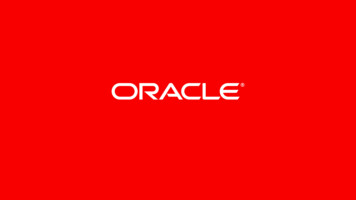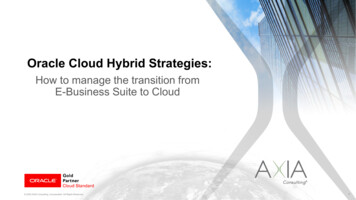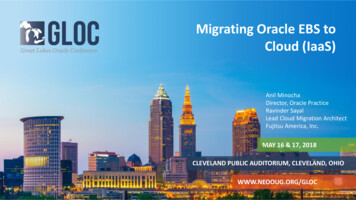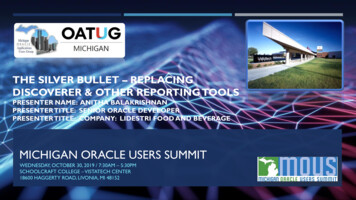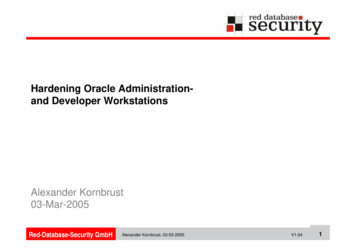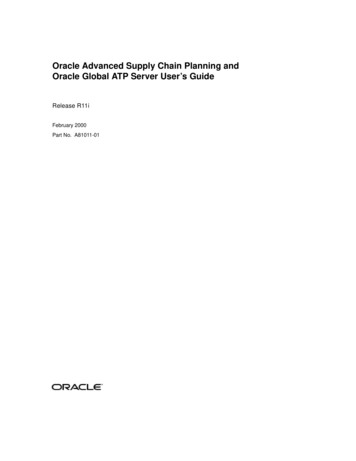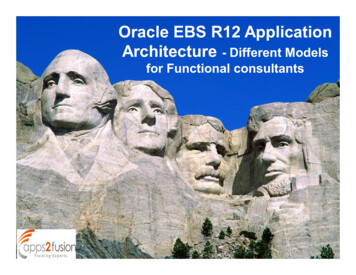
Transcription
Oracle EBS R12 ApplicationArchitecture - Different Modelsfor Functional consultants
PresenterPresenter: Sivakumar GanesanB.Sc, ACA, ICWA, PMP, PDIM, CIMA (Adv Dip)Mail: sivakumar3009@gmail.comAbout the Author 14 Years of Oracle EBS ExperienceHave Implemented Oracle EBS for Complex IndustriesSolution Architect and Subject Matter ExpertWell known for his Publications in– Business Flow in Oracle Applications– Accounting Flow in Oracle ApplicationsInvolved in development of several custom extensionsExperience in Fresh, Upgrade & Re-implementation ProjectsProblem solver & Alternate Solution providerConvincing Customers on the Best PracticesSpecialized in Accounting impact across Oracle EBS modulesIntegration / Interface of Multiple SystemsReviewer: My Sincere Thanks to my friend Ramesh Bommisetty for review ofthis document and providing valuable feedback2
Agenda Oracle R12 Application Architecture - Different ModelsAdvantages and Disadvantages of each modelRecommendations3
Acronyms BG – Business GroupLED – LedgerLE – Legal EntityOU – Operating UnitInv Org – Inventory OrganizationLOB – Line of Business (Refers to Balancing Segment in this document)MOAC – Multi Org Access ControlGBPA – Global Blanket Purchase AgreementVMI – Vendor Managed Inventory4
DisclaimerThe information in this document is the opinion of the author, not of OracleCorporation. Any content, materials, information or software downloaded orotherwise obtained through the use of the site is done at your own discretionand risk. Oracle shall have no responsibility for any damage to your computersystem or loss of data that results from the download of any content,materials, information or software.5
My First ERP Implementation Lesson fromthe CFO of the Client“Software should beconfigured according toBusiness andBusiness should not beamended according tothe Software”6
IntroductionThe primary purpose ofthis document is toenhance the knowledge ofOracle Application R12Architecture toØ Functional ConsultantsØ Project ManagersØ Technical consultantsØ and last but not theleast to the Customer aswell7
Suggested Way forward for Oracle EBSR12 Application Architecture1. Make the Customer to understand the Oracle Application Architecture8
Suggested Way forward for Oracle EBSR12 Application Architecture2. Evaluate the Right Model for Customer Organization along with customer9
Suggested Way forward for Oracle EBSR12 Application Architecture3. Discuss with Stakeholders of the Organization to decide the most suitable model10
Suggested Way forward for Oracle EBSR12 Application Architecture4. Configure the Most Suitable Model for the Organization with scalability for the future11
Suggested Way forward for Oracle EBSR12 Application Architecture5. Implement and Gain acceptance from the Business12
IntroductionIn order to explain the concept, I am using the example of AVIS BusinessGroup throughout this presentation (Reverse of my name SIVA)The AVIS Group is selling Sports equipment in the name of AVIS SportsGoods LLc., in US and UK and they have another business of owning playgrounds in US in the name of AVIS Sports Grounds LLc.,.13
Prerequisites for proper Oracle ApplicationArchitecturev Organization Structurev Clearly defined Policies and Procedures of the Organization Financials Human Resources Purchasingv Business Functions Centralized or Decentralized Financials Human Resources Purchasingv Delegation of Authority (Approvals)v Implementation of Shared Servicesv Reporting Requirements14
Oracle R12 ArchitectureJobGradePositionBusiness GroupCompetencyEmployees HRPeople GroupManagementControl & ReportingCAGRBalancing Entity/FundsLedgerFinancial ReportingPersonalAnalysisPayrollBal Seg 1Bal Seg 2Legal EntityTax InformationOperating UnitOperational ControlFlexfield Security RuleInventory / MFG /Stock ControlAccess Control byInv.OrgAccountingFlex fieldOperationalControl & ReportingInventoryOrganization15
Organization Structure Example16
Organization Structure ExampleImportant Note: Always Design your structure to have BG, Ledger, LE, OU andinventory org in Parent /child model and never design one child linked to multipleParentsExample: Please follow the application architecture design as per sample Diagramprovided below in Oracle Applications Administrator user guide17
Important Control at Each Level perInstanceCommon gal EntityBusiness Group Employees Employee Numbering Employee Movement Payroll Key Flex fields (Job, Grade) Assignment Single or Multiple BG HR Organizations Security ProfileLedger Calendar Currency Chart of Accounts Accounting Convention P&L and Balance Sheet Balancing Segment Single or Multiple Ledgers Document Sequencing Journals / Period ClosingLegal Entity Establishment Registrations Tax Bank Inter company Transactions Link to Balancing Segment Single / Multiple Legal Entities Intercompany Exceptions History and Contact InfoOperating Unit Sub ledger Transactions Security Sub Ledger Period closing Intra company Transactions Document Category Customer / Supplier Sites Single or Multiple OU Shared Services SLA/Reconciliation/ReportingInventory Org Costing Method Access Control Sub Inventory Transactions Sub Inventory Inventory Period Closing Items (Row /Rack /Bin) Single or Multiple Inv Org Inventory Transfers Reconciliation / Reporting
Control Level for Key Flex fieldsKey Flex fieldsModuleControlAccounting Flex fieldGeneral LedgerLedger LevelCategory Flex fieldAssetsInstanceAsset Key Flex fieldAssetsInstanceLocation Flex fieldAssetsInstanceAccount AliasesInventoryInstanceItem CatalogsInventoryInstanceItem CategoriesInventoryApplicationOracle Service Item Flex fieldServiceInstanceSales OrdersInventoryInstanceStock LocatorsInventoryInstanceSystem ItemsInventoryInstanceSales Tax Location Flex fieldReceivablesApplicationTerritory Flex fieldReceivablesInstancePublic Sector BudgetingPublic Sector BudgetingApplication19
Control Level for Key Flex fieldsKey Flex fieldsModuleControlBank Details Key Flex FieldPayrollBusiness GroupCost Allocation Flex fieldPayrollBusiness GroupPeople Group Flex FieldPayrollBusiness GroupTraining ResourcesLearning ManagementBusiness GroupCAGR Flex fieldHuman ResourcesBusiness GroupCompetence Flex fieldHuman ResourcesBusiness GroupGrade Flex fieldHuman ResourcesBusiness GroupJob Flex fieldHuman ResourcesBusiness GroupPersonal Analysis Flex fieldHuman ResourcesBusiness GroupPosition Flex fieldHuman ResourcesBusiness GroupSoft coded Key Flex fieldHuman ResourcesBusiness GroupActivity Flex fieldEnterprise Performance FoundationApplicationAHL RouteComplex Maintenance, Repairs and OverhaulInstance20
Different Architecture Models21
Data Partition between HR & Finance22
Business Group Business Group represents the highest level inthe structure such as the consolidated enterpriseor a major division of a company.The business group is an organization that is setup and configured in Oracle Human Resources.Currently ‘Business Group’ has no other purposebut to segregate HR information. If you request alist of employees (in any module) you will onlysee those employees in the ‘Business Group’ ofwhich your ‘Operating Unit’ is a part.Multiple ‘Legal Entities’ can relate to a single‘Business Group’.The business group is used to administer HumanResources payroll and benefits for employees.A business group is often related to countryspecific legislationThe jurisdictions it represents roughly correspondto nations. If a group of nations unite together onemployment laws, it is possible to implement asingle business group for them.The business group is partitioned into separatefiles of Human Resources information and isused to administer Human Resources payroll andbenefits for employees.Has no accounting impact23
Business Group24
Difference between Single BG VsMultiple BGTouch PointSingle Business GroupMultiple Business GroupKey Flex fieldOnly one Key Flex field Segments acrossall Ledger, Legal Entity and OperatingUnit(Job, Grade, Position, Costing, PeopleGroup, Competency)You can have different Key Flex fieldStructure for each Business GroupPayroll ProcessingOnly One CurrencyEach BG can have different currency.More Suitable, if you have operation inmore than one countryEmployee numberingYou can use either Manual or Automatic.For each Business Group, you can seteither Manual or AutomaticEmployee MovementPossible to transfer employees acrossdifferent entitiesYou cannot transfer employee from oneBusiness Group to another. You need toEnd date and Recreate in anotherBusiness GroupPayrollYou can have multiple Payrolls linked toone or more ledgers. Payroll entries aretransferred to GL or CM and not to APSame as single Business GroupHR LegislationYou can have only one LocalizationPatch Applicable to the countryEach BG can have different Localizationapplicable to specific country25
Single Business Group (BG)26
Single Business Group Advantages &DisadvantagesTouch PointAdvantagesDisadvantagesKey Flex fieldMore suitable to setup multiplecompanies under one Business Grouphaving common Job, Position, GradeEtc.,If you have different Job, Grade,Position etc., for each company, thenyou need to define multiple businessgroupsPayroll CurrencyEach Company under one BusinessGroup can have separate or multiplePayroll if the payment currency is sameIf Payment currency is different, thenthere is only a workaround solution andthe company needs to bear theexchange differencesEmployee NumberingYou can use either Manual or Automatic.If you have multiple companies underone Business Group, then you cannothave for one company manual andanother company automaticEmployee MovementPossible to transfer employees acrossdifferent entitiesPayrollYou can have multiple Payrolls linked toone or more ledgers. Payroll entries aretransferred to GL or CM and not to APApproval HierarchyPosition Hierarchy across multiplecompanies can be set under one BGLocalizationYou can have only one LocalizationPatch Applicable to the countryYou cannot have multiple LocalizationPatch within one Business Group27
Multiple Business Group (BG)28
Multiple Business GroupAdvantages & DisadvantagesTouch PointAdvantagesKey Flex fieldYou can have different Key Flex field(Job, Grade, Position etc.,)Structure foreach Business GroupPayroll CurrencyEach BG can have different currency.More Suitable, if you have operation inmore than one countryEmployee NumberingFor each Business Group, you can seteither Manual or AutomaticEmployee MovementYou cannot transfer employee from oneBusiness Group to another. You need toEnd date and Recreate in anotherBusiness GroupPayrollYou can have multiple Payrolls linked toone or more ledgers. Payroll entries aretransferred to GL or CM and not to APApproval HierarchyLocalizationDisadvantagesSetting Position Hierarchy acrossmultiple companies under multiple BG isnot possibleEach BG can have different Localizationapplicable to specific country29
Deciding factors for BusinessGroup (BG)Determining factors for Single Business Group or MultipleBusiness Groupv No of country in the scope of implementation and HRModules is in scope for all countries or notv More than one Key Flex field Requirementv Job, Grade, Position, Costing, Competency, PeopleGroupv Employee Numberingv HR Legislation30
LedgerLedger consists of your Chart of Accounts, Calendar, FunctionalCurrency and Accounting Convention (new in R12).LedgerChart of nctionalcurrency31
Differences between Single Ledger& Multiple LedgerTouch PointSingle LedgerMultiple LedgerPeriod ClosingGL Period closing will be only one for allentitiesEach Entity can have separate GLPeriod closingCalendar, Currency,Chart of Accountsand AccountingConventionSame for all but GL Period closing is onefor all entitiesIt can be same or Different, but GLperiod closing is separate for eachentity. If the Calendar and COA is sameacross multiple ledgers, then we can seta Ledger set to simplify the transactionprocessDocument SequenceMultiple Journal Categories to be createdfor each entity and some Personalizationis required to restrict one entity usinganother entity Journal categoryEach Entity can have unique Journalcategory and Document sequence. NoPersonalization is requiredConsolidationNot Required, Managed through FSGReportsConsolidation Required. No of Steps aremore (Revaluation, Translation,Consolidation and Elimination)32
Single Ledger ModelAVIS USLedgerAVISSPORTSUSBusiness Unitfor OperationalControl for PO,AP, ARInventory,Transactionsand StoresControlAVIS nitOperatingUnitInv OrgInv OrgOperatingUnitInv OrgInv Org33
Single Ledger Model Advantages &DisadvantagesTouch PointAdvantagesDocument SequencingThe Transaction Numbers will be jumbledacross multiple entities and there will notbe any audit trailThe Transaction numbers will not beunique for a legal entity it is across alllegal entities. The Sequence numbersare for a Ledger and not for a LegalEntityPeriod ClosingGL Period close is one step across alllegal entities.It serves as a centralized control, but inreal practice it is not a practical solution.Each entity cannot close the ledger asand when they complete their work.Security RulesWe need to define security rules to restrictaccess of one legal entity accessing otherlegal entity within one ledgerInvolves lot of maintenance workCross Validation Rules If an account combination not to becreated, then we need to define CVRConsolidationDisadvantagesInvolves lot of Maintenance workConsolidation handled through FSG.Data PartitionExtremely DifficultChart of AccountsStructureMaintenance is simple with one chart ofaccountsSecurity Access toBalancing SegmentControlled through Data Access SetOnly one Chart of Account Structure forall
Oracle shall have no responsibility for any damage to your computer system or loss of data that results from the download of any content, materials, information or software. 5. My First ERP Implementation Lesson from the CFO of the Client 6 “Software should be configured according to Business and Business should not be amended according to the Software” Introduction 7 The primary purpose .
